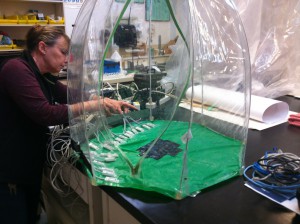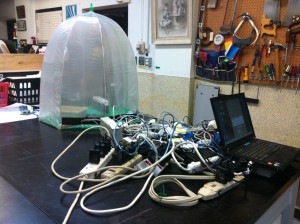Last May it was time to calibrate the Museum’s electronic environmental data loggers, little boxes attached to walls of collections storage and exhibit areas that record temperature and relative humidity. In the pictures below, you can see the myriad of cables, electrical cords and equipment assembled for the operation. It looks like mayhem, but in fact, it was all under control. In the background, you see a plastic humidity tent, which was used to create an environment separate from that in the conservation lab. Humidity was created by placing hot water in a shallow pan. This is all that’s needed in a closed environment to create humid conditions (remember that the next time you leave standing water around your house). The data logger probes were placed into the humidity tent and the readings recorded by the loggers, which were plugged into the laptop computer in the foreground. Each logger requires a power source as well as a network cable, hence the mess of interwoven cords. I’m sure our textile conservators would have preferred that we neatly plait them or otherwise create a pleasing pattern.
In the end, the loggers were all adjusted to read the same temperature and RH as the one created in the humidity tent, thereby calibrating them to the same standard. This is so very important, as we use these loggers to monitor the environments in our storage and exhibit areas, to promote preservation of the collections. They even send us email alarms if things go awry. If the temperature in a storage area gets too high, chemical reactions speed up that can cause damage, such as hardening of rubber and leather artifacts. If the relative humidity in an exhibit area gets too high, mold may disfigure collections or cause metals to corrode. Low RH causes glues to fail and mounted animal specimens to split. It’s the job of the conservators to ensure the best preservation environments for our world class collections.




